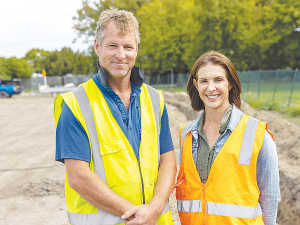Deep Dive: Shifting weeds with subsurface irrigation
Distancing subsurface irrigation from the vine trunk results in less undervine vegetation with no significant reduction in yields.
 Gary and Penny Robinson of Robinson Subsurface Drip Irrigation at Linwood Park in Christchurch where their underground irrigation system is being installed.
Gary and Penny Robinson of Robinson Subsurface Drip Irrigation at Linwood Park in Christchurch where their underground irrigation system is being installed.
Cust dairy grazers Gary and Penny Robinson have advanced their subsurface drip irrigation (SDI) trial with positive feedback from farmers following field days at trial blocks in North Canterbury and Central Otago.
The system is also being installed at Linwood Park in Christchurch.
Gary and Penny are participating in Next Generation Farming; a project that aims to help farmers meet tough nitrate caps while maintaining their viability. As part of this project, farmers like the Robinsons are using innovation and demonstrating its productivity and environmental benefits to their neighbours in the region and beyond.
Waimakiriri Landcare Trust (WLT) and Waimakariri Irrigation Limited (WIL) have partnered with the Ministry for Primary Industries (MPI) for the project, with support from MPI’s Sustainable Food and Fibre Futures fund along with Environment Canterbury, Ballance, and DairyNZ.
SDI’s low-pressure system saves water and power and improves crop yields by eliminating surface water evaporation and reducing the incidence of weeds and disease. Water is applied directly to the root zone of the crop and not to the soil surface.
Gary and Penny recently held two field days at trial blocks in Cust, North Canterbury and in Maniototo, Central Otago which were well received by farmers and industry partners.
Despite heavy rain during the Cust field day, Penny says farmers were keen to learn about subsurface irrigation and seeing the system in the ground and being able to ask practical questions built a stronger understanding of how the system works.
“The weather wasn’t in our favour, but we still had a good turnout, and everyone was very engaged and interested. From the questions asked and discussion we had, SDI does seem to be accepted as a viable solution and option for irrigation in New Zealand.”
Over 50 farmers turned out for the Maniototo field day where the difference between the 18-hectare test block using subsurface irrigation and the adjacent block using traditional irrigation was evident, says Gary.
“It was a stinking hot day, and it was perfect because they have had a hot and dry summer down there so you could really see the difference with lush green grass growing on the block where we have installed the SDI.
“The farmer, Luke Jeffries, is really impressed with the system and after the field day we had quite a few local farmers approach us to learn more.”
Gary and Penny are now focused on gathering data to prove the benefits of the subsurface drip irrigation system.
Dairy prices have jumped in the overnight Global Dairy Trade (GDT) auction, breaking a five-month negative streak.
Alliance Group chief executive Willie Wiese is leaving the company after three years in the role.
A booklet produced in 2025 by the Rotoiti 15 trust, Department of Conservation and Scion – now part of the Bioeconomy Science Institute – aims to help people identify insect pests and diseases.
A Taranaki farmer and livestock agent who illegally swapped NAIT tags from cows infected with a bovine disease in an attempt to sell the cows has been fined $15,000.
Bill and Michelle Burgess had an eye-opening realisation when they produced the same with fewer cows.
It was love that first led Leah Prankerd to dairying. Decades later, it's her passion for the industry keeping her there, supporting, and inspiring farmers across the region.
President Donald Trump’s decision to impose tariffs on imports into the US is doing good things for global trade, according…
Seen a giant cheese roll rolling along Southland’s roads?